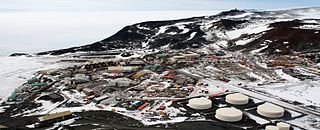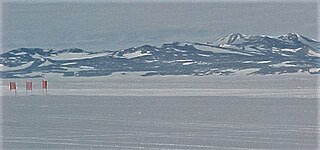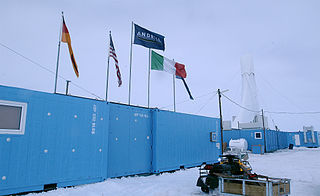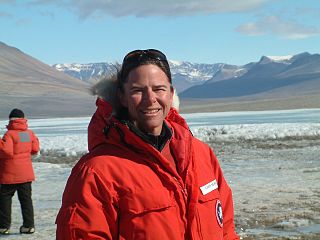
McMurdo Station is an American Antarctic research station on the southern tip of Ross Island, which is in the New Zealand–claimed Ross Dependency on the shore of McMurdo Sound in Antarctica. It is operated by the United States through the United States Antarctic Program (USAP), a branch of the National Science Foundation. The station is the largest community in Antarctica, capable of supporting up to 1,500 residents, and serves as one of three year-round United States Antarctic science facilities. All personnel and cargo going to or coming from Amundsen–Scott South Pole Station first pass through McMurdo. McMurdo Station continues to operate as the hub for American activities on the Antarctic continent. By road, McMurdo is 3 kilometres (1.9 mi) from New Zealand's smaller Scott Base.

Palmer Station is a United States research station in Antarctica located on Akwers Island, the only U.S. station on the continent located north of the Antarctic Circle. Initial construction of the station finished in 1968. The station, like the other U.S. Antarctic stations, is operated by the United States Antarctic Program (USAP) of the National Science Foundation. The base is about as distant from the equator as Fairbanks, Alaska.

The United States Antarctic Program is an organization of the United States government which has a presence in the Antarctica continent. Founded in 1959, the USAP manages all U.S. scientific research and related logistics in Antarctica as well as aboard ships in the Southern Ocean.

Nathaniel B. Palmer is an icebreaking research vessel (RVIB) owned by Offshore Service Vessels LLC, operated by Edison Chouest Offshore, Inc. and chartered by the United States National Science Foundation. Nathaniel B. Palmer is tasked with extended scientific missions in the Antarctic. Nathaniel B. Palmer was purpose-built for and delivered to the NSF by Edison Chouest Offshore's North American Shipbuilding facility in 1992. Nathaniel B. Palmer is able to support up to two helicopters, accommodates up to 45 science and technical personnel, has a crew of 22 and is capable of missions lasting up to 65 days. The vessel is named after merchant mariner and ship builder Nathaniel Brown Palmer, credited by some historians as the first American to see Antarctica.
Operation Deep Freeze is codename for a series of United States missions to Antarctica, beginning with "Operation Deep Freeze I" in 1955–56, followed by "Operation Deep Freeze II", "Operation Deep Freeze III", and so on.. Given the continuing and constant US presence in Antarctica since that date, "Operation Deep Freeze" has come to be used as a general term for US operations in that continent, and in particular for the regular missions to resupply US Antarctic bases, coordinated by the United States military. Task Force 199 was involved.

Pegasus Field was an airstrip in Antarctica, the southernmost of three airfields serving McMurdo Station. It closed due to excessive melting in the summer season caused by warmer temperatures combined with dust and dirt blown in from nearby Black Island. The last flight was on December 8, 2016 and it was replaced by Phoenix Airfield with flights starting in February 2017.
The Antarctica Marathon® may have been the first for-profit sporting event held in Antarctica, on January 28, 1995. The event is now held every year in late February or early March. The 42.195-kilometre race is held on King George Island, one of the largest Antarctic Islands just off the Antarctic Peninsula. There is also a half-marathon held at the same time. The start and finish is at Bellingshausen Station, and the course passes the Artigas Base (Uruguayan), the Frei Base (Chilean) and the Great Wall Base (Chinese). The course follows a gravel road that connects the bases and changes each year based on the base operations as well as road and weather conditions.

RV Laurence M. Gould is an icebreaker used by researchers from the United States' National Science Foundation. for research in the Southern Ocean. The vessel is named after Laurence McKinley Gould, an American scientist who had explored both the Arctic and Antarctic. He was second in command of Admiral Richard E. Byrd's first expedition to Antarctica from 1928 to 1930. He helped to set up an exploration base at Little America on the Ross Ice Shelf at the Bay of Whales.

ANDRILL is a scientific drilling project in Antarctica gathering information about past periods of global warming and cooling.

The Byrd Station is a former research station established by the United States during the International Geophysical Year by U.S. Navy Seabees during Operation Deep Freeze II in West Antarctica.

The Chapel of the Snows is a non-denominational Christian church located at the United States' McMurdo Station on Ross Island, Antarctica and is one of eight churches on Antarctica.
Ellen Mosley-Thompson is a glaciologist and climatologist. She is a Distinguished University Professor at Ohio State University and director of their Byrd Polar and Climate Research Center. She is known as a pioneer in the use of ice cores from the Polar Regions for paleoclimatic research and is an influential figure in climate science. She is an elected fellow of the American Association for the Advancement of Science, the American Geophysical Union and an elected member of the National Academy of Sciences.

The Captain Pieter J. Lenie Base is an Antarctic summer base operated by the United States located at Copacabana Beach, Admiralty Bay. About two kilometers northwest of this base is the Polish research station Arctowski. Pieter J. Lenie Base, also known as Copa, consists of three small buildings at the foot of Rescuers Hills, near Llano Point.
Helen Amanda Fricker is a glaciologist and professor at Scripps Institution of Oceanography at the University of California, San Diego where she is a director of the Scripps Polar Center. She won the 2010 Martha T. Muse Prize for Science and Policy in Antarctica.
Jennie Darlington was an American explorer and, with Jackie Ronne, one of the first women to overwinter on Antarctica, during the winter of 1947-1948. She and Ronne were part of a team that re-occupied a former U.S. station on Stonington Island in 1946. Darlington became part of the expedition by chance: she had intended to only go as far as Valparaiso, Chile with her husband, Harry Darlington, who was the pilot for the Ronne expedition. The newlyweds spent their honeymoon in Antarctica after Jackie Ronne and her husband requested Jennie's presence.

Louise Tolle Huffman is an American teacher with over 30 years of teaching experience with many years focused on polar science and climate studies, and has written educational outreach books and articles on Antarctica. She is the Director of Education and Outreach for the US Ice Drilling Program Office (IDPO), responsible for outreach efforts highlighting IDPO scientists and their research results.

Christine Siddoway is an American Antarctic researcher, best known for her work on the geology and tectonics of the Ford Ranges in western Marie Byrd Land. Other discoveries relate to preserved records of continental-interior sedimentation during the Sturtian glaciation, Cryogenian Period, in Rodinia, and evidence of a reduced Pliocene extent of the West Antarctic ice sheet, based upon investigation of clasts transported to/deposited in deep water by Ice rafting in the Amundsen Sea.

Alison Murray is an American microbial ecologist and Antarctic researcher, best known for studying the diversity, ecology and biogeography of Antarctic marine plankton dynamics of the plankton over the annual cycle; and her work demonstrating the existence of microbial life within an ice-sealed Antarctic lake. She studies how microorganisms persist and function in extremely cold and harsh environments, including those that lack oxygen and biological sources of energy.
While crime in Antarctica is relatively rare, isolation and boredom affect certain people there negatively and may lead to crime. Alcoholism is a known problem on the continent and has led to fights and indecent exposure. Other types of crime that have occurred in Antarctica include illicit drug use, torturing and killing wildlife, racing motorbikes through environmentally sensitive areas, assault with a deadly weapon, attempted murder and arson. Sexual harassment also has been reported.

Icestock is an all-day, outdoor music festival held annually at McMurdo Station, Antarctica on or around New Year's Day. It was started in 1989 by three United States Antarctic Program employees who wanted to host a music festival in the style of Woodstock. It is the southern-most music festival in the world.














